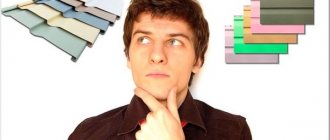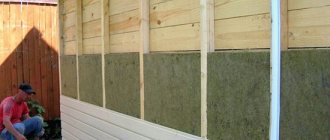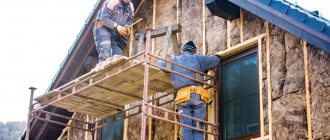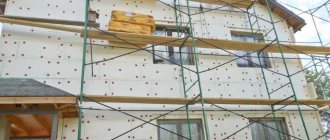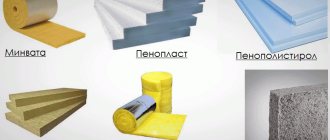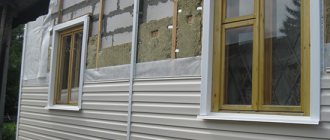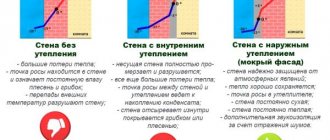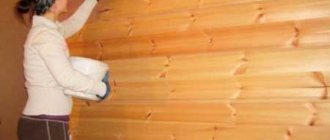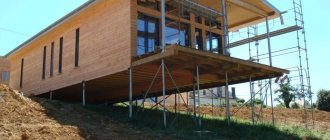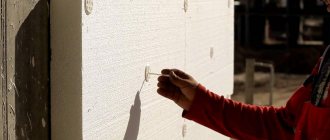Siding has a lot of positive characteristics, but cannot boast of thermal insulation properties. That is why, when finishing residential buildings, the walls are first insulated, and only then the covering panels are attached. Which insulation for siding has the best properties, what criteria should be used to choose it, and how to properly perform insulation with your own hands - this will be discussed in the article.
Insulation for siding
Basic requirements for insulation under siding
In every hardware store, insulation materials are presented in a wide range, and it is very difficult for an inexperienced person to understand them. Roll and slab, expensive and cheap, domestic and foreign production, different densities and thicknesses - how to determine exactly what you need?
Insulation under siding
First of all, you need to be guided by the requirements that the material must meet:
- low thermal conductivity is one of the most important qualities that insulation should have. The lower this indicator, the less heat escapes through the walls of the room;
- resistance to temperature changes and moisture - since the insulation is located on the outside of the building, it is exposed to high and low temperatures, and not all materials retain their original properties. When moistened, the same thing happens, in addition, the risk of fungus appearing under the casing increases;
- environmental friendliness - the presence of toxic compounds in the composition poses a health hazard and requires additional protective measures when performing thermal insulation;
- fire safety - insulation should not contribute to the spread of fire during a fire and emit toxic smoke when burning. Therefore, preference should be given to fire-resistant and self-extinguishing materials;
- durability - here it is meant that the insulation must fully retain its characteristics, including geometric shapes, throughout its entire service life. Unfortunately, many materials shrink after just a few years or begin to crumble, which leads to a decrease in thermal insulation properties.
Not all materials fully possess such qualities, and below we will consider only the most suitable ones. Next, you need to take into account the installation method, especially if you are going to do all the work yourself. Roll insulation is less convenient to install; it is much easier to attach the slabs.
Roll and slab insulation
Useful tips
We recommend starting work from the rear facade of the building - firstly, possible errors will be less visible here, and secondly, if you get to the front facade, you will already have good practice in installing siding. When the first panel is reliably defined, we proceed to extension.
So, it is quite possible to install siding with insulation yourself, the main thing is to follow the technology and in the process do not forget to once again check the quality of the work - this will save you from the need to redo it in the future.
Korovin Sergey Dmitrievich
Master of Architecture, graduated from Samara State University of Architecture and Civil Engineering. 11 years of experience in design and construction.
Siding is becoming more and more popular every day. Lamellas made from high-quality raw materials are durable and practical. This material replaced wooden panels and, due to its availability, has become a real favorite of the construction market. Unlike natural cladding, it does not require additional protection from external factors.
Probably, many will be interested in knowing how houses are insulated from the outside with siding, and we will try to give a detailed answer to this question. To begin with, I would like to introduce you more closely to the technical characteristics of the material, and they are quite good here.
Types of insulation
The most popular insulation materials for siding today are:
- mineral wool;
- based on polystyrene foam;
- blow-in insulation (ecowool, penoizol, polyurethane foam).
Mineral wool, according to GOST 52953-2008, is divided into three types - stone, slag and glass wool.
GOST R 52953-2008 - download for free. THERMAL INSULATION MATERIALS AND PRODUCTS
GOST R 52953-2008
To produce the first type, basalt and silicate rocks, as well as their mixtures, are used; slag wool is made from metallurgical waste, glass wool is made from waste from the glass industry. These insulation materials are very thin fibers compressed into thick sheets, which are produced in the form of rolls and mats of various sizes and densities. Additionally, they can have a foil coating. As a rule, to insulate a house under siding, only stone and glass wool are used, since slag insulation is less water resistant.
Mineral wool insulation with foil layer
An example of using mineral wool for insulation under siding
Expanded polystyrene insulation, polystyrene foam and EPS, are lightweight, dense sheets formed from a large number of air-filled closed cells. Thanks to this structure, these insulation materials practically do not absorb water. They are produced only in the form of slabs, differing in density, size, and degree of flammability.
Insulation based on polystyrene foam
Extruded polystyrene foam is perfect for the Russian climate
Blown-in materials are those that are applied to the base using a special installation under high pressure. After drying, they form a durable, seamless coating with excellent thermal insulation properties.
Blown-in insulation - ecowool
Seamless home insulation
External insulation technology using foam plastic
To insulate the walls of a private house from the outside, you can use polystyrene foam. The procedure for foam insulation involves the sequence of work performed:
- preparation of walls (cleaning of debris, sealing cracks, priming);
- applying the necessary markings;
- attach a profile at the bottom of the wall, which will serve as the basis for the even laying of the first row of slabs;
- attach the foam by applying the adhesive solution, starting from the bottom corner. The second row of sheets is fastened in a cross pattern;
- after the glue has completely dried, secure the foam with umbrellas;
- the joints are sealed with polyurethane foam, if large, with pieces of polystyrene foam. After hardening, excess foam is cut off;
- To finish slopes and corners, you should use special corners that are glued to the reinforcing mesh tape.
Laying sheets in a checkerboard pattern
Fastening sheets
Sectional diagram of insulation
Further along the wall, a reinforcing mesh is attached to the layer of glue and leveled with a spatula. After the glue has dried, the surface is primed and covered with finishing plaster or other decorative materials.
CAREFULLY!
It is better not to insulate wooden houses with polystyrene foam, since with breathable wood it is better to use porous insulation that can allow moisture and air vapor to pass through.
In this case, mineral wool is ideal.
Characteristics of mineral wool insulation
Stone wool
Technical characteristics of basalt wool
Material properties
Of all the varieties of stone wool, basalt insulation is considered the most popular. It is distinguished by the lowest content of binding components, which includes formaldehyde resins and phenol, which are hazardous to health, and therefore is one of the most environmentally friendly materials. The fibers that make up the insulation are not scratchy and quite smooth, so they do not cling to clothing, do not cause irritation on the skin, and you can perform work without protective gloves.
Basalt insulation
Technical characteristics of basalt wool
| Options | Values |
| Thermal conductivity | 0.035-0.041 W/(m K) |
| Water absorption | no more than 2% |
| Vapor permeability | 0.55 mg/mhPa |
| Density | 30-225 kg/m3 |
| Working temperature | from -180 to 700 ᵒС |
| Flammability degree | non-flammable material |
| Material thickness | from 30 to 150 mm |
| Dimensions | 500x1000 mm, 600x1000 mm, 600x1200 mm |
Manufacturers produce stone wool in the form of mats, soft, semi-rigid and hard slabs, and in rolls. For installation under siding, rigid and semi-rigid slabs are most convenient, but roll insulation is more suitable for horizontal and inclined surfaces.
Advantages of stone wool:
- the material is easy to cut, light in weight, and does not create difficulties during installation;
- does not burn and does not emit harmful substances;
- microorganisms, including fungi, do not develop in it;
- reduces noise level by up to 20%;
- service life is 40-50 years without loss of basic characteristics.
Minuses:
- the production of the material requires high costs; accordingly, prices for stone wool are quite high;
- when cutting and shaking the material, thin fibers break and form very fine dust, which easily penetrates the respiratory tract. As a result, a respirator should always be used during thermal insulation work.
There are many manufacturers who, to reduce the cost of the manufacturing process, use various industrial wastes instead of pure rocks, but at the same time pass off their products as high-quality basalt insulation. It is very difficult to visually recognize a fake, especially for an inexperienced person, so buy stone wool from well-known, time-tested brands. Nowadays the following manufacturers enjoy a high reputation in the market of thermal insulation materials:
- Rockwool;
- Knauf;
- Ursa;
- Isover;
- TechnoNIKOL.
Insulation manufactured by Technikol
Mineral wool ISOVER
Glass wool
The popularity of glass wool has dropped noticeably with the advent of basalt and slag insulation on the market, but it is still used in various fields. In appearance, it is not very different from stone wool, but it is more fragile, so many manufacturers additionally reinforce the material by stitching with steel threads. The peculiarity of glass wool is that the glass fibers, at the slightest impact, are destroyed and form fine dust, which easily eats into the skin, penetrates the respiratory tract, eyes and causes severe irritation. For this reason, you can work with glass wool only in protective clothing, a respirator and goggles.
Glass wool
Specifications
| Options | Values |
| Thermal conductivity | 0.039-0.047 W/(m K) |
| Vapor permeability | 0.6 mg/mh*Pa |
| Water absorption | 1,5-1,7% |
| Density | 11-25 kg/m3 |
| Flammability degree | from NG to G1 |
| Material thickness | 50-100 mm |
| Dimensions | 610x1170 mm, 600x1250 mm |
| Working temperature | from -60 to 450 ᵒС |
Advantages of glass wool:
- Due to its low thermal conductivity, glass wool perfectly retains heat in the house. A layer of material 50 mm thick is similar in thermal insulation properties to brickwork one meter thick;
- no toxic additives are used in the production of glass wool, so it does not emit harmful substances even when exposed to high temperatures;
- glass wool boards are lightweight and can be compressed in packaging 6 times their original volume with subsequent straightening, which simplifies the transportation of the insulation;
- the material is easy to cut and install on walls;
- Microorganisms do not develop in glass wool and insects and rodents do not breed;
- Compared to other fiber insulation materials, glass wool is much cheaper.
Minuses:
- the high fragility of the fibers requires enhanced protection and caution in work; increased loads on the material should be avoided;
- the average service life of glass wool is 10 years, then it shrinks severely and does not provide even minimal thermal insulation of the walls;
- glass wool absorbs moisture vapor and water, which leads to a complete loss of thermal insulation characteristics.
Glass wool in rolls
Advice. For siding, slabs covered with fiberglass with a density of about 30 kg/m3 are best suited. To avoid getting low-quality insulation, pay attention only to certified glass wool from leading manufacturers, for example, Knauf, Isover, Ursa, and the domestic brand “Neman”.
Prices for mineral wool
Mineral wool
Criterias of choice
The main selection criteria are price and free time. If the construction budget allows, then ecowool would be the best choice. This is especially true for wooden houses, since the seamless method allows you to close the smallest cracks.
On the other hand, you can insulate the building yourself with basalt wool, the difference will be insignificant, and you will save a good amount. Therefore, in matters of insulation, two factors are always important: money and free time.
It is imperative to pay attention to vapor permeability. The seller can easily describe this property as both negative and positive. Moreover, in any of the judgments he will be right. However, vapor permeability is necessary and it is better to choose materials that can “breathe”.
Characteristics of polystyrene foam insulation
Styrofoam
Polystyrene foam has very low hygroscopicity, in which it is significantly superior to fiber insulation. Walls lined with foam plastic also do not require additional wind protection. This is one of the most budget-friendly insulation options, although not the most effective. Due to the vapor permeability of the material, it is necessary to regularly ventilate the room to prevent condensation from accumulating on the walls.
Styrofoam
Pros of polystyrene foam:
- affordable price;
- low thermal conductivity;
- light weight;
- ease of installation.
Minuses:
- In terms of sound absorption, foam plastic is inferior to other types of insulation;
- sheets of material break easily, so care is required during transportation and installation;
- foam is damaged by rodents;
- It is a flammable material and produces toxic smoke when burned.
Insulation of facades with foam plastic
EPS (extruded polystyrene foam)
This material has characteristics similar to polystyrene foam, but in all respects it is much better. EPS is widely used in industrial and private construction; its installation does not require much effort or special skills.
Extruded polystyrene foam
Pros:
- high density and strength of the material;
- almost zero hygroscopicity;
- excellent thermal insulation properties;
- good noise absorption performance;
- long service life;
- relatively light weight.
Minuses:
- the cost of EPS is approximately 20-30% higher than that of polystyrene foam;
- does not allow the walls to “breathe”;
- can be damaged by rodents;
- refers to flammable materials.
| Options | Styrofoam | EPPS |
| Thermal conductivity | 0.035 W/(m K) | 0.028 - 0.032 W/(m K) |
| Water absorption | 0,5 — 1% | 0,1 — 0,4% |
| Density | 11-35 kg/m3 | 30-40 kg/m3 |
| Flammability degree | G1 – G4 | G1 - G4 |
| Thickness | 20-100 mm | 40-100 mm |
| Dimensions | 500x500 mm, 600x1200 mm, 1000x1000 mm | 580x1180 mm, 600x1200 mm |
Prices for foam plastic
Styrofoam
Making a box
At the first stage, prepare everything you need: a small cardboard box, always with a lid, fabric of different colors, scissors, glue and lace.
It is best to do the craft on a comfortable desk. Then you can carefully lay out everything and not damage the workpieces.
When making a box, follow the sequence of instructions.
- Clear the box of any labels, stickers, glue or tape residue.
- Strengthen the bottom by additionally gluing the base.
- From any fabric, cut a rectangle in the shape of a bottom. Then glue the fabric to the cardboard.
- The most interesting creative stage is decorating the box with fabric. It is advisable to choose colors two shades brighter than the source material. Here you can safely conduct creative experiments.
- Next we glue the outer side and the lid with lace. To do this as carefully as possible, you should find a video on how to make a box with your own hands. You need to apply the glue delicately, because... As a result, traces of glue may remain on the box.
- You can add appliqués or designs inside for an organic combination. For example, in the shape of a heart in a bright scarlet shade.
Leave your craft to dry for a while and that’s it, your box is ready.
Characteristics of blow-in insulation
Ecowool is a new material made from cellulose fibers. It contains a binder - lignin, fire retardants and boric acid as an antiseptic. Ecowool is a loose mass that is applied dry or “wet” method.
Ecowool
Penoizol and polyurethane foam have a cellular structure and are applied to walls in liquid form. They are light in weight, so they exert almost no load on the base, but at the same time cover the entire area with a dense, uniform layer. With this method of insulation there is no need to level the walls and install wind protection, which greatly simplifies installation.
Urea-formaldehyde foam - universal insulation
Insulating a house with foam insulation
Pros:
- absence of cold bridges;
- durability;
- low thermal conductivity;
- speed of installation.
Minuses:
- these materials are more expensive than other insulation materials;
- For application it is necessary to have special expensive equipment and experience working with it.
Thermal insulation with polyurethane foam
| Options | Ecowool | Penoizol |
| Thermal conductivity | from 0.037 to 0.042 W/(m*K) | from 0.031 to 0.041 W/(m*K) |
| Layer density | 28-65 kg/m3 | 5-75 kg/m3 |
| Vapor permeability | 0.3 mg/(mhPa) | 0.21–0.24 mg/(mhPa) |
| Flammability degree | G2 | G1 |
| Working temperature | from -40 to +120 0С | -60 + 80 ᵒС |
How to choose?
The parameters of each home are unique and require special attention. Installation work will vary depending on what kind of building it is: a country house among a large, ventilated space or a building among houses of the same type where there is no free movement of air flows.
The correct selection of the necessary materials is one of the difficult issues when doing your own cladding and insulation. The choice largely depends on the building material from which the house is made. For example, for construction from solid wooden beams, mineral wool is preferable, and for brick or cinder block, almost all types of insulation are preferred.
It is also recommended to use mineral wool for a timber frame house. This is due to the fact that it is the most fireproof material for wooden buildings.
As for external walls made of aerated concrete, experts advise insulating them with penoplex.
In turn, professionals in the field of construction and installation have identified a number of qualities that insulation should have.
Based on these standards, it will be much easier to make a choice:
- the most important quality is low thermal conductivity;
- the insulation must be hydrophobic or absorb moisture in minute quantities;
- it must “maintain its shape” (not crumble, slide, flow, or change shape due to temperature);
- Particular attention should be paid to its safety for humans; the material must also be fire-resistant and not emit pungent odors when heated;
- It is unacceptable to contain substances that will promote the growth of bacteria, fungi and mold.
Siding also requires attention. Its choice must be approached wisely, since it is affected by natural phenomena (wind, rain, snow, temperature changes, etc.). Each type of siding has its pros and cons, but among the wide variety, the greatest preference is given to vinyl siding panels. Thanks to its properties, it tolerates “street conditions” well, does not fade in the sun for a long time, and is also a “breathable” and safe material.
If you choose metal panels, then you should think about the level of complexity of their installation. A beginner in this matter cannot cope on his own. As for their characteristics, do not forget about their susceptibility to corrosion. Plus, when it rains slantingly, water drops hit the walls and create a high level of noise.
If you still have doubts about the choice, then real consumers will be the best guide in this matter. The best thing to do is talk to the home owners. From them you can find out what pros and cons they identified during operation.
Installation of insulation under siding
Regardless of the material chosen and the method of fastening it, you first need to properly prepare the surface. To do this, remove everything that could interfere with the work - lighting devices, trim, decorative elements and other objects, and then carefully inspect the walls. There is no need to level the base, but you should definitely seal the cracks and remove the fungus.
Wooden beams or metal profiles are used as lathing for siding. If you prefer timber, you should pre-treat it with antiseptic impregnation to avoid damage to the wood from condensation and the development of mold.
Wooden beam sheathing
Prices for different types of bars
Bar
Wall insulation with mineral wool
Step 1. A frame made of timber with a section of 50x50 mm is fixed to the wall. The beams are attached vertically using self-tapping screws and dowels; the distance between the posts should be 1.5-2 cm less than the width of the insulation. It is imperative to control the vertical position of the racks with a building level so that all elements of the sheathing are in the same plane.
We fix the timber frame
Step 2. Mineral wool slabs are alternately inserted between the beams, slightly pressing the edges. After installation, the material easily straightens and tightly fills the cells of the sheathing. If necessary, the slabs are trimmed with a knife or a fine-toothed hacksaw.
Alternately insert the slabs between the beams
Step 3. If the insulation is planned to be installed in two layers, horizontal beams made of timber are attached on top of the racks with self-tapping screws at the same distance. Next, the mineral wool slabs are reattached.
Installing the second row of timber
Step 4. A windproof membrane is attached over the insulation. Since its width is not enough to cover the entire area of the wall, it is secured with horizontal stripes, starting from the bottom of the facade. To fix the membrane, it is most convenient to use a stapler. Each subsequent strip is laid with an overlap of at least 10 cm. To increase the tightness of the coating, the joints are taped along the entire length.
We attach the windproof membrane
Step 5. Next, install the guides under the siding strictly according to the level using mounting plates. The plates are attached with self-tapping screws to the sheathing in increments of 40 cm. An air gap of about 3-5 cm should remain between the guides and the windproof membrane.
Installing guides under the siding
After this, they begin covering the facade with siding panels. As you can see, the technology is quite simple and anyone can do it. The most important thing is to secure the slabs tightly so that they do not dangle between the racks. If there are gaps left, heat will escape and all efforts will be in vain.
Let's start covering the facade with siding panels
Siding prices
Siding
Insulation with extruded polystyrene foam
Step 1. On the wall, mark the location of the hangers for the guides according to the level. The hangers should be attached along the entire facade in increments of 40 cm. Holes are drilled at the marked points, dowels are inserted and the hangers are secured with screws.
Attaching the hangers
Step 2. Take an EPS board, apply it to the wall and press it a little so that traces of the hangers are imprinted. Using these marks, cuts are made in the insulation with a knife or a special cutter. Next, the slab is again placed against the wall and put on hangers, pressing it tightly to the base.
Step 3 . The remaining slabs are fastened in exactly the same way, trying to make the joints as thin as possible. If gaps have formed here and there during the work, they need to be sealed with polyurethane foam using a gun.
We fix all the EPS boards
Step 4. After covering the facade with insulation, they begin to install guide profiles under the siding. The profiles are attached to hangers that protrude from the heat-insulating layer; a ventilation gap 2-3 cm wide is left between the guides and the insulation. Next, the siding is attached.
Installation of guides
This insulation can also be attached using umbrella dowels and special glue. In this case, it is more convenient to first mount the sheathing to which the siding will be attached. Glue is applied to the insulation, then the plate is inserted between the guides and pressed against the base. Upon completion of installation, the slabs at the joints are additionally fixed with umbrella dowels.
Ecowool insulation
Characteristics of ecowool
Insulating walls with ecowool can be done in two ways - dry and wet. The first method is not reliable enough, since the material is blown through small holes in the protective film, and it is impossible to control the density and uniformity of the filling. In this regard, the wet method is more convenient; the whole process takes place in plain sight. It is this second method that we will consider.
Equipment for installation of ecowool
Step 1. The walls are cleaned of dust, cracks and other defects are eliminated. The guides for the siding will be strengthened strictly according to the level in increments of about 50 cm. The guides must be fastened using mounting plates so that the thickness of the frame is at least 10 cm.
Fixed guides
Step 2. Ecowool is poured into a blowing machine, a water-gel solution is added there, and mixed until smooth.
Step 3. Turn on the installation and apply the viscous mass to the walls in a dense layer. Joints and corners are treated especially carefully so that there are no voids left.
Insulation of walls with ecowool
Applying ecowool to the wall
Ecowool insulated wall
Step 4. Allow the insulation to dry completely, after which the siding panels are mounted to the sheathing.
In a similar way, the house is insulated with foam insulation and polyurethane foam. Many companies rent out spraying equipment, which is much cheaper than purchasing equipment. But in order to do everything efficiently, certain skills are needed, and it is better for a beginner to hire specialists for this.
Video - Insulation for siding
Video - Insulation under siding with mineral wool
Tools and materials
Special tools and devices are required to insulate the outside of the house with mineral wool under the siding. The material is prepared based on the required number of layers. A layer of waterproofing is taken, and a lining material, for example, roofing felt, is used as it. Protection from moisture is done by coating - using bitumen or modern compositions for work.
The next material is mineral wool. For the base, stone wool or a fiberglass variety is used. You will need a metal profile on which to attach the siding. Hardware is used for fixing to a brick base, foam block or aerated concrete.
Tools needed:
- assembly knife with spare blades;
- building level, tape measure;
- electric hammer, drill, grinder;
- bitumen finishing brush.
It is not recommended to make a frame from timber, since the material absorbs moisture and can bend over time. Siding is used as finishing.
How much does TechnoNikol mineral wool cost?
The characteristics of TechnoNikol insulation also include cost. In this section we provide the approximate cost of the most popular TechnoNikol stone wool insulation.
| Name | Size | Thickness | Number of slabs per package | Square | Price | Price 1 sq. meters |
| Rocklight | 1200Х600 mm | 50 mm | 12 | 6,91 | 514 rub. | 74 rubles |
| Technoblock PROF | 1200Х600 mm | 80 mm | 6 | 6,91 | 918 rub. | 133 |
| Technolight Optima | 1200Х600 mm | 50 mm | 12 | 8,64 | 603 | 70 |
| Technofas Optima | 1200Х600 mm | 50 mm | 6 | 4,32 | 951 | 220 |
| GreenGuard insulation | 1200Х600 mm | 50 mm | — | 5,76 | 400 | 69 |
Mineral wool thermal insulation cylinders TechnoNikol brand CF 80 measuring 1200 by 20 mm and a diameter of 18 mm cost 50 rubles as of January 2022.
It is easy to notice that materials are available in different price segments. On the TechnoNikol website there is a division into three types of basalt wool: economy, standard and premium. Of course, everything depends not only on financial capabilities, but also on the needs of a particular home.
Polystyrene foam - fast, but not always good
Let's consider insulating the facade under siding using polystyrene foam. This material is easy to install. It is light and quite rigid, so it is firmly glued to the walls or attached to them using disc-shaped dowels.
However, this is where its advantages as a wall insulation end. In terms of price, this material in the first years of its appearance on the market was cheaper than mineral wool, but today their cost is almost the same. So the factor of saving money can be discarded. There is a lot of debate about the durability of polystyrene foam, but objectively this material cannot last more than 10-15 years, because, like all polymers, it quickly ages and deteriorates. The vapor permeability of polystyrene foam is very low.
Therefore, by insulating the walls with it, we are deprived of natural air exchange and voluntarily enclose our house in an impenetrable thermos. Excess moisture can only be removed with the help of ventilation or mechanical ventilation, releasing precious heat along with it into the street. Talk about foam being a good sound insulator is a common advertisement by manufacturers of this material. Moreover, foam plastic, rigidly fixed to the outer wall, under certain conditions, works as a sound amplifier, since it falls into the resonant frequency of sound vibrations - 70 - 7000 Hz (speech range). Digression from our topic, we note that foam plastic is best suited for insulating engineering communications (water supply, sewerage) and concrete floor screeds, since in this case such qualities as minimal water absorption and low thermal conductivity are in demand.
